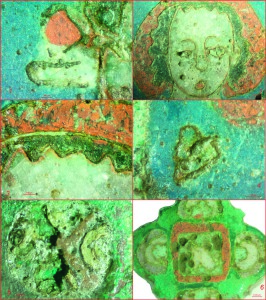 Nikolay A. Makarov*, Irina E. Zaitseva**
Nikolay A. Makarov*, Irina E. Zaitseva**
Institute of Archaeology R AS, Moscow, Russia
*E-mail: nmakarov10@yandex.ru
**E-mail: ydmit.ozherelyev@gmail.com
Keywords: medieval Rus, Christian antiquities, Suzdal Opolye, icon-pendants, enamel, holy warriors.
The article considers a gilded bronze rectangular icon-pendant of quadrifoliated shape decorated with enamel images on both sides. The object was found in the arable layer of the settlement Semenovskoye-Sovetskoye 3, 20 km away from Suzdal. The find dates back to the 12th – the first half of the 13th century. On one side of the icon in the central square sized 1.7 × 1.7 cm, there is an image of Christ Emanuel with a white cruciform halo with letter substitutes. The upper and lower leaves of the quadrifolium are decorated with a rhomboid geometrical pattern “gorodki”: red patterns against a white background enclosed in semicircles of blue. The side leaves have white enamel letters IC and XC on a red background. On the reverse side of the icon in the central square, is an image of a young beardless saint with black curly hair in a red halo against a blue enamel background. The leaves of the quadrifolium are entirely covered with blue enamel, over which the letters are cut: on the upper leave – “HE”, on the left one – “CT”, on the right one – “E”, and on the lower one – “PЪ” (Nester). The enamel pendant found in the settlement is essential as it reveals the connection between archaeological antiquities of medieval settlements and the “high” culture sites of North-Eastern Rus, which are often perceived as phenomena isolated from their traditional cultural environment.
DOI: 10.31857/S086960630007224-5







